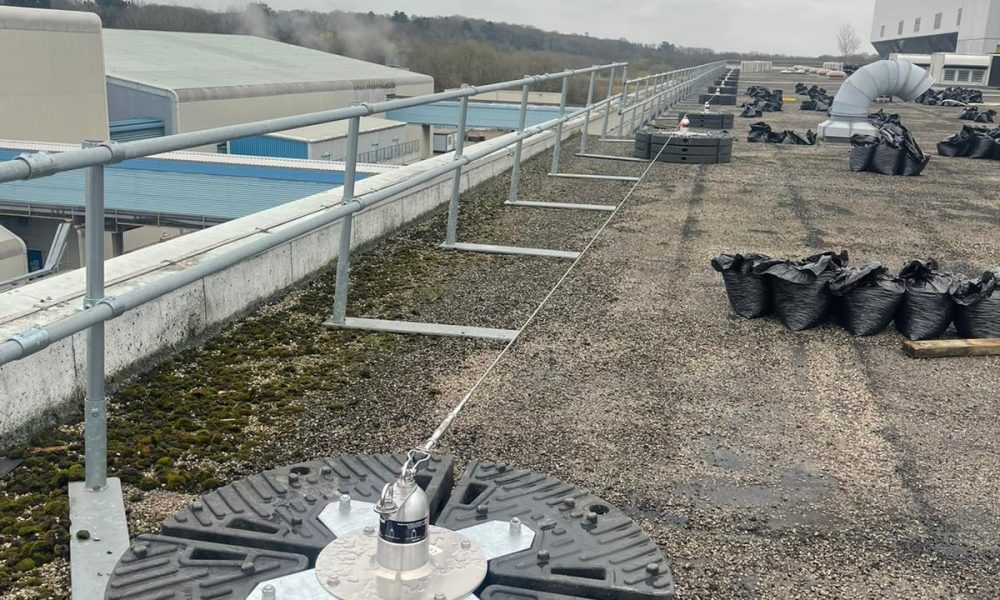
Mansafe
We supply design and install Horizontal lifeline systems.
Mansafe is a collective fall protection system that is designed to provide continuous protection to a group of workers who are working on a roof. It typically consists of a secure anchor point, a series of horizontal and vertical rails, and a lanyard or harness that connects the worker to the system. Mansafe is a passive system, meaning that it does not require the worker to actively engage with it, as it provides continuous protection across the roof area.
A horizontal lifeline is a fall protection system that is designed to provide individual workers with protection while they move along the roof. It typically consists of a series of posts or anchors that are attached to the roof, and a wire rope or cable that is strung between them. Workers are required to wear a harness and connect to the horizontal lifeline using a lanyard, which allows them to move along the wire rope or cable while remaining protected from fall hazards.
Both Mansafe and horizontal lifeline systems are commonly used on roofs to provide fall protection to workers. They are typically installed by trained professionals and require regular inspections to ensure that they are in good working condition. These systems are designed to prevent falls from happening by providing a continuous fall protection system and can be an essential part of any comprehensive roof safety plan.
Fall Arrest
The fall arrest position of a Mansafe is typically located at the end of the working area, where a worker might be at risk of falling from a height.
In a Mansafe system, the fall arrest position is typically located at the first anchor point, where the worker connects to the system using a shock-absorbing lanyard or a retractable lifeline. In the event of a fall, the lanyard or retractable lifeline will automatically lock onto the Mansafe cable, preventing the worker from falling any further and allowing them to safely return to a standing position.
It is important to note that the precise location of the fall arrest position may vary depending on the particular Mansafe system in use and the specific design of the roof. The fall arrest position should be carefully planned and installed by a qualified professional to ensure that it is in the optimal location to provide maximum protection to workers. Regular inspections should also be carried out to ensure that the Mansafe system and the fall arrest position are in good condition and ready to function effectively in the event of a fall.
The fall arrest position of a Mansafe is the point at which the system activates to protect the worker from a fall. In a Mansafe system, the fall arrest position typically refers to the anchor point where the worker’s harness is connected to the system.
The anchor point is typically located at the start and end points of the horizontal rail, or where the rails change direction. It is positioned to ensure that the worker is continuously connected to the system as they move along the roof, whether they are working in a standing or kneeling position.
The fall arrest position of a Mansafe is critical to ensuring worker safety, as it is the point where the system is designed to activate and prevent a fall. Proper installation and positioning of a Mansafe system is essential to ensure it provides adequate protection, and it should only be installed or maintained by trained professionals to ensure it meets all necessary safety standards.
In summary, the fall arrest position of a Mansafe system is the anchor point where the worker’s harness is connected to the system, located at critical points along the horizontal rail to ensure continuous protection while working on a roof.
Fall Restraint
All restraint positioning involves positioning the worker in such a way that they cannot fall from a height. This is achieved by creating a physical barrier between the worker and the edge of a roof or other elevated surface. Fall restraint systems are designed to keep the worker from reaching the edge of the work area, preventing the possibility of a fall altogether.
A fall restraint system typically consists of a secure anchor point, along with a lanyard or other device that limits the worker’s range of movement. By ensuring that the worker cannot come too close to the edge of the work area, fall restraint systems can prevent falls from occurring and keep workers safe.
Fall restraint positioning requires careful planning and implementation, as the system must be designed to fit the specific work environment and the tasks being performed. The system must provide adequate freedom of movement for the worker while also preventing them from reaching the edge of the work area.
Regular inspections and maintenance are essential to ensure that fall restraint systems continue to function properly over time. By ensuring that workers are properly positioned and protected, fall restraint systems can help prevent falls and keep employees safe while working at heights.
0 Comments